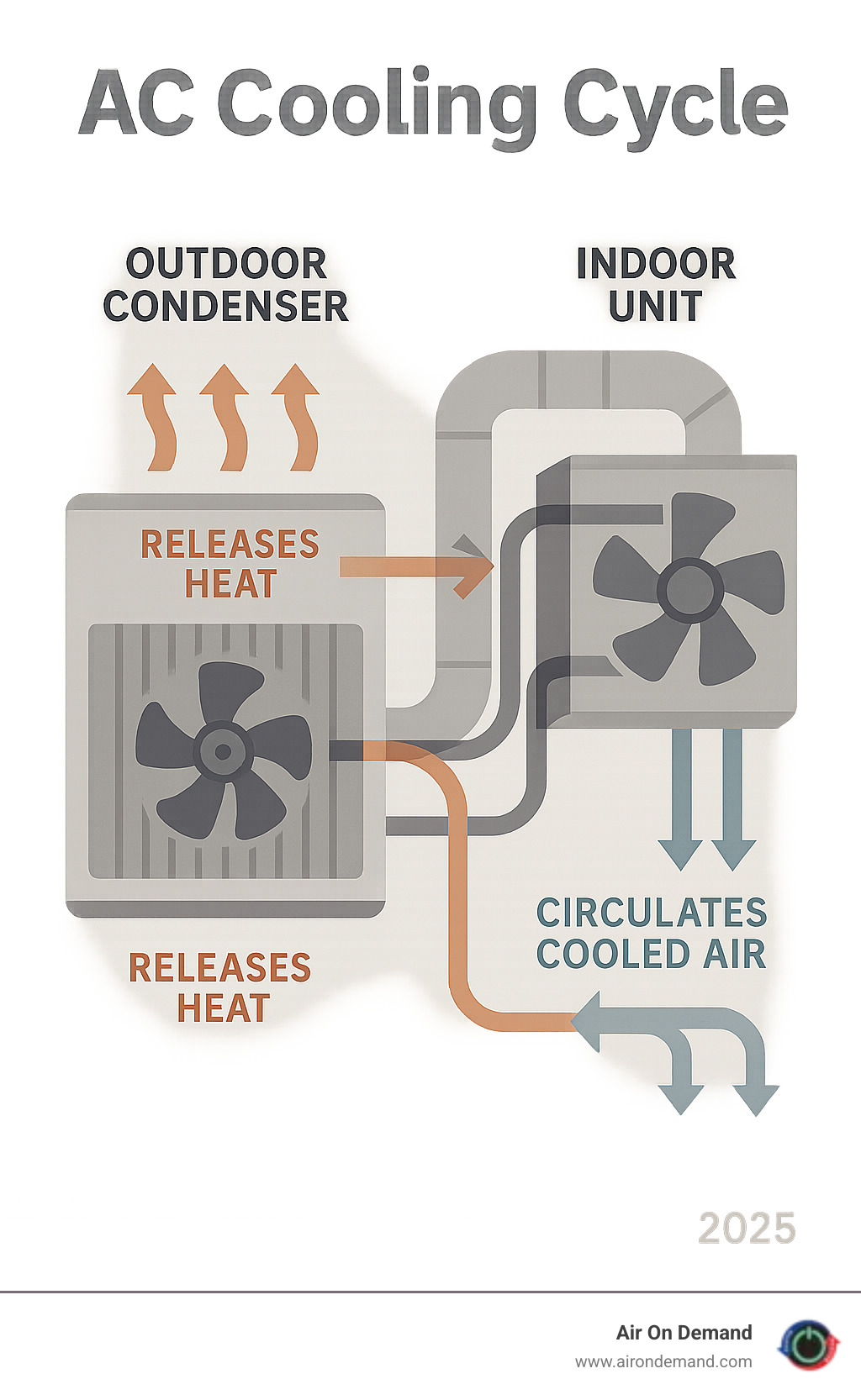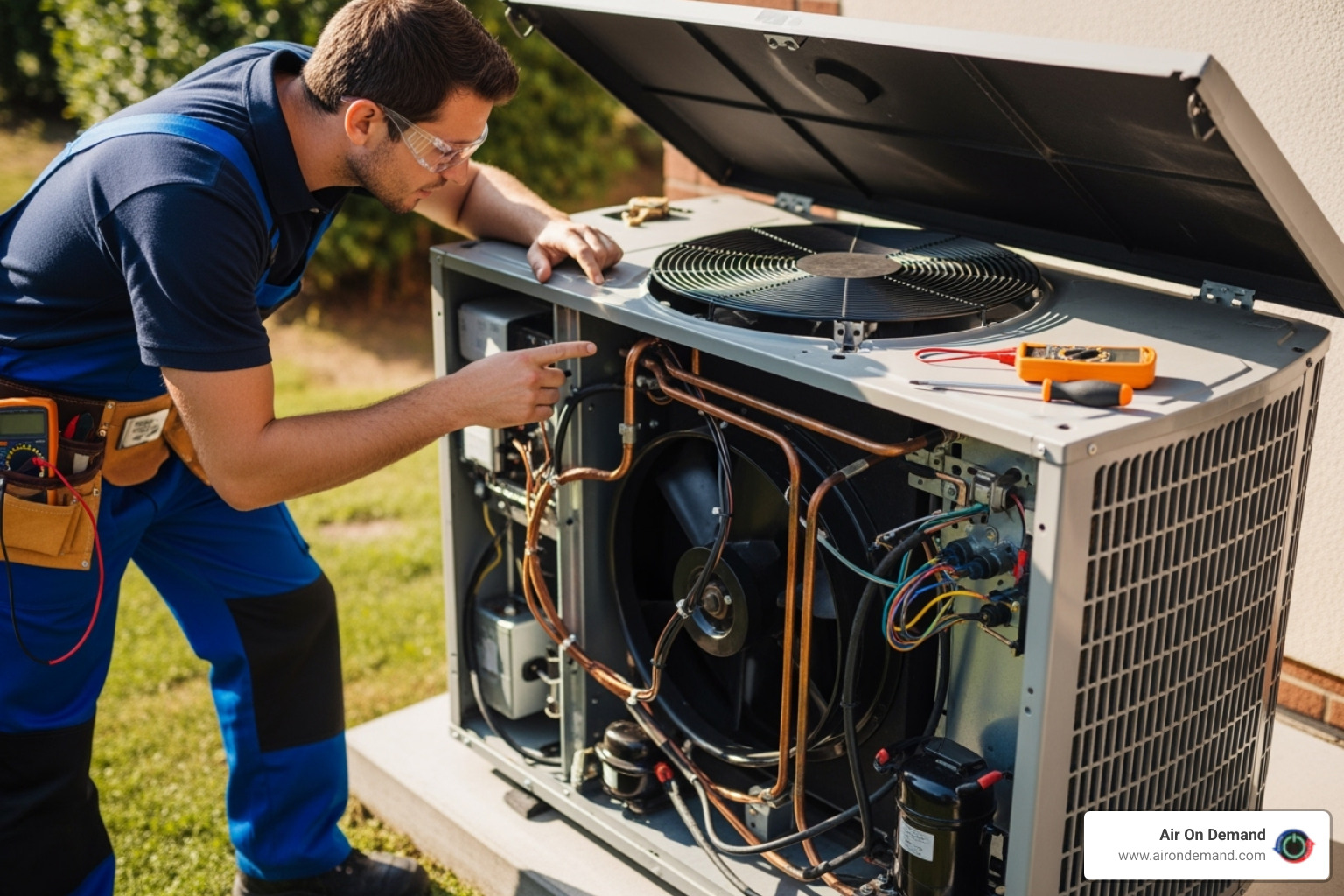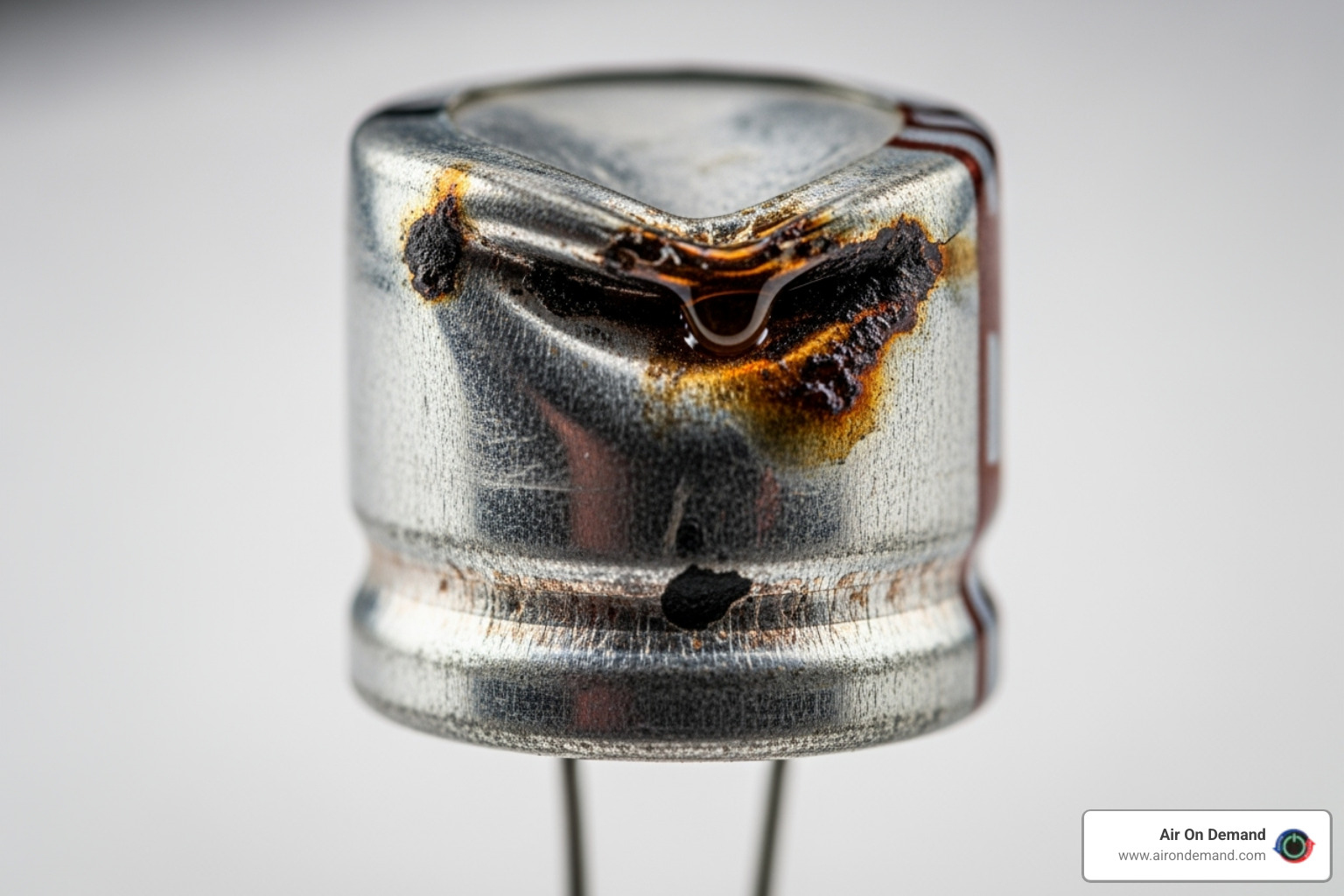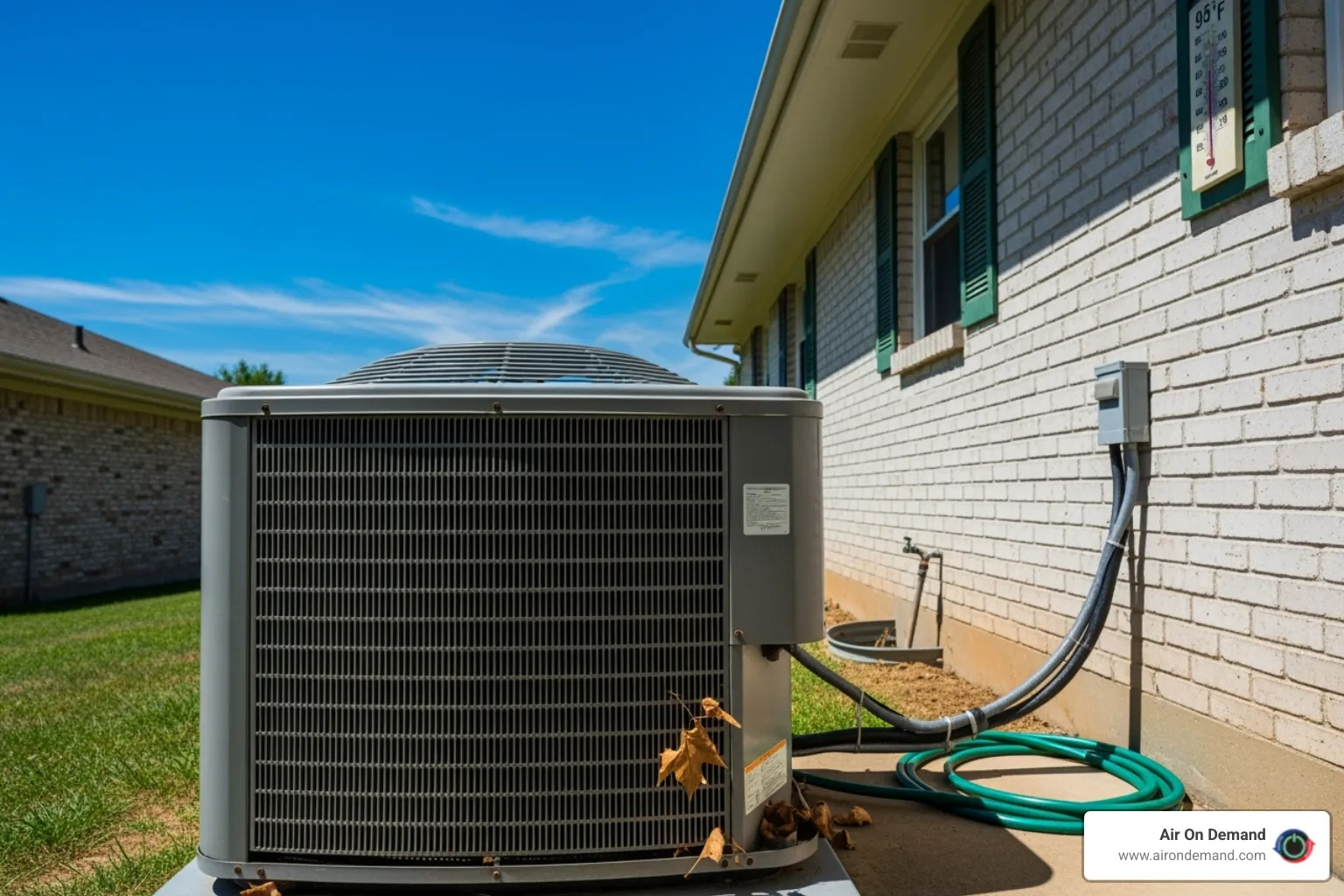When Your AC Fan Won't Budge: The Problem That Can't Wait
When your AC fan not spinning becomes apparent on a sweltering summer day, it's more than an inconvenience—it's a sign of potential system failure and expensive repairs. Here's what you need to know right away:
Quick Diagnosis for AC Fan Issues:
- Power Issues: Check thermostat settings and circuit breakers first
- Capacitor Problems: Listen for humming sounds - usually indicates a bad start capacitor
- Motor Failure: Complete silence or grinding noises suggest motor problems
- Debris: Look for leaves, twigs, or obstructions blocking the fan blades
- Contactor Issues: Clicking or chattering sounds point to electrical relay problems
Finding your outdoor fan motionless while hot air blows from your vents is a clear sign something is wrong. Your AC system depends on two critical fans: the outdoor condenser fan, which releases heat, and the indoor blower, which circulates cool air. When either stops, the entire cooling process breaks down.
The stakes are high. Running your AC with a dead fan risks overheating the compressor, a repair that can cost as much as replacing the entire system. However, many fan issues have simple causes you can check yourself.
This guide walks you through basic safety checks and helps you identify when professional intervention is needed, allowing you to diagnose the problem quickly and avoid costly mistakes.

The Unsung Hero: Why Your AC Fan's Job is Critical
Your air conditioner is a carefully orchestrated system with two hardworking fans. These unsung heroes are critical for your comfort.
Your indoor blower fan lives inside your furnace or air handler, moving cooled air through your ducts and into every room. It also pulls warm air back to the unit to be cooled. Without this circulation, cool air remains trapped in the unit while your home stays hot.
The outdoor condenser fan is often the first to show signs of trouble. It pulls hot air through the condenser coils, expelling the heat absorbed from inside your home. This is a vital step in the refrigerant cycle, where your AC works by blowing air across the cooling media. The refrigerant absorbs indoor heat, travels outside, and the condenser fan helps release that heat so the cycle can repeat.
When your AC fan not spinning becomes reality, the consequences are severe. Heat builds up in the system, causing the condenser coils to overheat and the compressor to work overtime. This can lead to expensive repairs or a complete system replacement.
The telltale sign is your AC running constantly without cooling. The system tries to work, but without proper airflow, it fails, causing your electric bill to climb while your home gets hotter. These fans are the heart and lungs of your cooling system; when they stop, everything else quickly fails.
Your DIY Diagnostic Checklist: Simple Fixes to Try First
When you find your AC fan not spinning, don't panic. Many fan issues have simple causes you can check yourself.
Before troubleshooting, always turn off power to your AC unit. Flip the circuit breaker and use the outdoor disconnect switch near your unit. This prevents the system from starting unexpectedly while you inspect it.
We'll methodically check the most common culprits, starting with the simplest causes. Many homeowners find their "broken" AC just needed a thermostat adjustment or a quick cleanup.
Step 1: Check Your Thermostat Settings
Your thermostat controls everything, so ensure it's telling your AC to work.
Start with the mode setting. Is it switched to "Cool"? Family members can accidentally change these settings. Next, check that your temperature setting is lower than the current room temperature. If your home is 78°F and your thermostat is set to 80°F, your AC won't run.
The fan setting can also be the issue. Most thermostats have "Auto" and "On" options. In "Auto," the fan only runs during active cooling. Switch it to "On" to test if the fan motor itself is working.
If you have a battery-powered model, check the thermostat batteries. Low batteries can prevent proper communication with your AC unit. The Department of Energy recommends starting by checking your thermostat for this reason.
Step 2: Inspect the Circuit Breaker
If your outdoor unit is completely silent, you might have a tripped circuit breaker. This safety feature cuts power to your AC to prevent electrical problems.

Go to your main electrical panel and look for the AC breaker, typically a double-wide switch labeled "AC," "HVAC," or "Air Conditioner."
A tripped breaker will be in the middle "tripped" position or flipped to "Off." To reset it, push the breaker firmly to "Off," then back to "On." You should feel it click into place.
Give the system a few minutes to respond. Warning: if the breaker trips again immediately, do not keep resetting it. This indicates a serious electrical issue requiring professional help. You can learn more about how to resetting a circuit breaker if you're unsure.
Step 3: Look for Debris and Obstructions
Your outdoor AC unit can collect leaves, twigs, dirt, and other debris. Sometimes, the solution to an AC fan not spinning is a simple cleanup.
With the power off, clear away any visible debris from around and inside the unit. Units can get clogged with leaves and grass clippings.
Check for animal nests, as critters sometimes build homes in AC units. Also, ensure there is at least two feet of clear space around all sides of your unit. Blocked airflow from shrubs or other items puts extra strain on your system.
Look at the fan blades themselves. Bent or damaged blades can prevent proper spinning and cause rattling or grinding noises. If you see damage, call a professional.
Finally, check your indoor air filter. A clogged filter restricts airflow, forcing your fans to work harder. Replace it if it's dirty—this should be done every 1-3 months.
If your AC fan still not spinning after these checks, it's time to investigate the mechanical causes we'll explore next.
Why Your AC Fan is Not Spinning: Common Culprits
If the basic checks don't solve your AC fan not spinning problem, it's time to investigate the mechanical components. The sounds your unit makes—or doesn't make—are your biggest clues.
A humming outdoor unit with a motionless fan points to a different issue than a unit that's completely silent. A lack of any sound often indicates an electrical supply problem, like a tripped breaker or failed contactor. But a distinct hum without fan movement usually means one thing: a bad capacitor.

The Faulty Capacitor: The Most Common Cause for an AC Fan Not Spinning
Capacitors are small parts that do a huge job. The start capacitor provides the initial jolt of energy your fan motor needs to start spinning. Without it, the motor can't overcome inertia.
Capacitor problems are usually easy to identify. Humming or buzzing sounds from the outdoor unit while the fan is still are the classic sign of a failing capacitor. You might also see the fan try to start, spinning slowly before stopping.

A visual inspection can also confirm the issue. A swollen or bulging top on the capacitor is a clear sign of failure, as is any sticky, leaking fluid. These are definitive signs that a replacement is needed.
You may have heard of the "stick test"—gently pushing a fan blade with a stick to see if it starts. This test is dangerous and should only be attempted by someone comfortable with electrical equipment. If, after restoring power, a gentle nudge gets the fan running continuously, you've confirmed a bad capacitor.
However, the stick test is diagnostic, not a fix. Capacitors store a dangerous electrical charge even when the power is off. While a blown capacitor is an affordable repair, it's a job for a trained professional.
The Burnt-Out Fan Motor
If the problem isn't the capacitor, the fan motor itself may have failed. This is more serious but still less expensive than replacing the compressor.
A failing fan motor has its own symptoms. Complete silence can mean the motor has seized or lost power. Conversely, grinding or screeching noises suggest worn internal bearings.
Overheating is another red flag. A motor working too hard will get hot, and you might smell electrical burning. If you tried the stick test and the fan won't move at all, the motor has likely seized.
Intermittent operation—working one day but not the next—is another sign of a deteriorating motor. The most common causes of motor failure are worn bearings or an electrical failure in the motor windings.
When your AC fan motor stops working, it's time to call a professional. Replacement requires specific tools and expertise.
The contactor is your AC system's main power switch. It takes low-voltage signals from the thermostat and sends high-voltage power to the compressor and fan motor. If it fails, the entire outdoor unit loses power.
Chattering or clicking noises are a cry for help. You might hear rapid clicking as it tries to engage or a single click followed by silence. This can happen if the contactor's internal contacts have deteriorated.
A technician's visual inspection may reveal pitted contacts, which are burn marks on the electrical connection points that prevent power from flowing.
Since a bad contactor affects both the fan and compressor, a completely silent outdoor unit often points to this component. While a defective contactor requires professional replacement, it's typically a straightforward repair.
Don't Risk It: When to Call an HVAC Professional
While DIY fixes are satisfying, some AC fan not spinning issues require a professional. The stakes are higher than you might think.
When your AC fan isn't working, your compressor—the heart of your system—is at risk of overheating. It generates immense heat, and without the fan to cool the condenser coils, temperatures can skyrocket.
Compressor overheating is often catastrophic. Homeowners who run their AC with a dead fan can face a complete system replacement. A burnt-out compressor often costs nearly as much as a new AC unit, turning a simple repair into a major expense.
There's also the real danger of electrical shock. Capacitors can hold a dangerous charge even when the power is off. Contactors and fan motors carry high voltage that requires proper safety equipment and training to handle.
System age is another factor. If your AC is 10-12 years old, a failing fan might be the first of many component failures. A professional can help you assess whether a repair is more cost-effective than a replacement.
AC problems that get worse without repair are a guarantee. A failed capacitor can lead to a burnt-out motor, which can cause an overheated compressor. This expensive domino effect is why prompt action is crucial.
Prevention is your best defense. Most fan failures develop over time and can be caught during routine maintenance. The Department of Energy recommends having your unit serviced at least once per year. Think of it as an annual physical for your AC to catch small problems before they become big ones.
When your AC fan not spinning problem is beyond simple fixes, it's time to call in the experts. Our team has the tools, training, and experience to diagnose the root cause and restore your system safely.
Frequently Asked Questions about a Non-Spinning AC Fan
When your AC fan not spinning becomes a reality, you'll have questions. Here are the most common concerns we hear from homeowners.
Is it OK to run my AC if the fan is not spinning?
The answer is an emphatic no. If you've confirmed your AC fan not spinning, shut down your air conditioner at both the thermostat and the circuit breaker immediately.
Running your AC without a working fan is like driving a car with a broken radiator fan—it will overheat quickly. Here's what happens:
- Risk of compressor burnout: The compressor generates immense heat and relies on the fan for cooling. Without it, the compressor can suffer permanent, costly damage.
- Frozen evaporator coils: When the system can't release heat outdoors, the indoor coils can freeze, leading to water damage and reduced cooling.
- Wasted energy: The system will run constantly without cooling your home, driving up your electric bill.
What might be a simple repair can quickly become as expensive as a new AC system. As one expert resource explains, it absolutely matters if the AC fan is not spinning, and the consequences of ignoring it are severe.
What does it mean if the fan starts when I push it with a stick?
If you safely perform the "stick test" and the fan starts and continues running, this strongly indicates a bad capacitor.
Your fan motor is receiving power but lacks the initial jolt from the capacitor to start spinning. Your push provides the manual force the capacitor should be supplying automatically.
This is diagnostic information, not a permanent fix. The capacitor needs professional replacement to restore proper function. This is one of the common air conditioning fan problems that require professional repair, but the good news is that it's a straightforward and affordable fix.
How much does it cost to fix a non-spinning AC fan?
The cost to fix an AC fan not spinning depends on the cause.
- Capacitor replacement is on the lower end of the cost spectrum. The part is inexpensive, and the repair is quick for a trained technician.
- Fan motor replacement is a medium-cost repair. The motor is a more expensive part, and the labor is more involved.
- Compressor replacement is the most expensive scenario. The cost is often so high that it makes more sense to replace the entire AC unit.
| Component Causing Issue | Relative Cost |
|---|
| Faulty Capacitor | Lower |
| Faulty Fan Motor | Medium |
| Faulty Compressor | High |
The key takeaway is that early intervention saves money. Addressing the problem quickly, when it's likely a capacitor or motor, prevents the cascading damage that leads to compressor failure.
At Air On Demand, we believe in transparent pricing and will always provide a clear estimate before starting any work.
Get Your Cool Back with Professional Help
When you're dealing with an AC fan not spinning, it's easy to feel overwhelmed. You now know how to perform basic troubleshooting, from checking the thermostat to clearing debris. However, the electrical components that often cause fan failures—like a faulty capacitor, a burnt-out motor, or a defective contactor—require professional expertise.
These repairs involve high-voltage components that are dangerous without proper training and tools. A professional diagnosis is invaluable, as an experienced technician can quickly identify the root cause and ensure your system's longevity.
At Air On Demand, we make HVAC problems disappear quickly and efficiently. Our team has deep expertise with all makes and models, including high-performance Daikin products. When your comfort is on the line, you need a lasting solution.
What sets us apart is our commitment to keeping you informed. From our convenient online booking to real-time service updates, we believe transparency builds trust. Our strong warranties, including Daikin's 12-year parts warranty and our own Comfort Promise, protect your investment long after the repair is done.
Don't let a non-spinning fan turn your home into a sauna. For expert AC repair in Kendall, FL, contact our team today! We're here to get your comfort back where it belongs.





